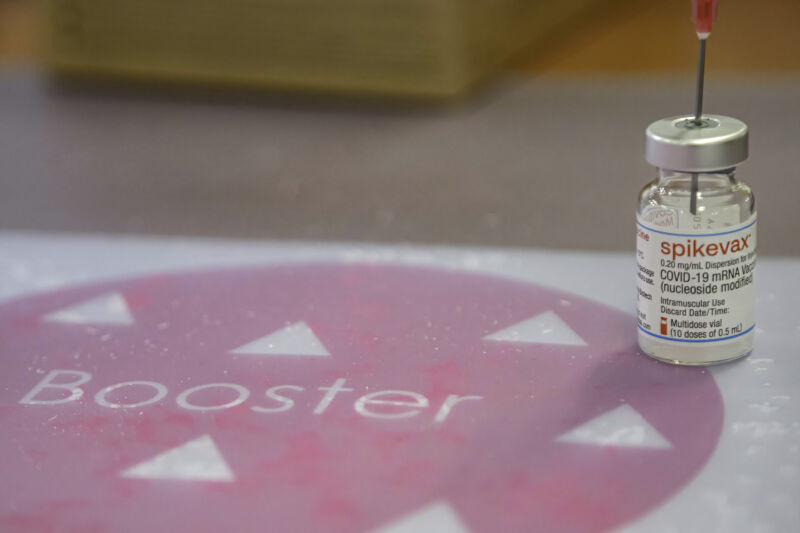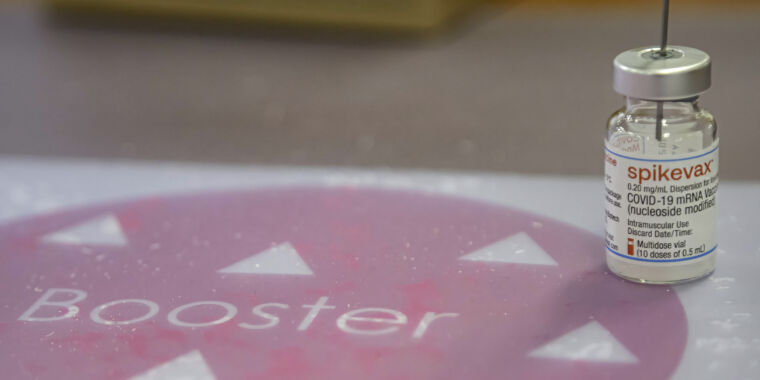
The type of COVID-19 booster dose you get later this year could depend on where you live.
Vaccine maker Moderna is working up two omicron-targeting boosters for different countries. If the company’s plans pan out, it will mark the first time that COVID-19 vaccines would target different versions of the pandemic coronavirus in different places. Until now, all vaccines, including boosters, have targeted the ancestral strain of SARS-CoV-2, first identified in Wuhan, China.
Both of Moderna’s next-gen booster candidates are bivalent vaccines, which target both the ancestral virus and some version of omicron. One booster option targets BA.1—the version of omicron that first burst out of South Africa last November, causing a towering wave of infection in the US in January 2022. That BA.1-based next-gen booster could be available in the EU, UK, Australia, and elsewhere later this month or early August. Moderna’s other booster option targets BA.4/5 and is intended for use in the US. However, it likely won’t be ready until early to mid-fall.
The US split follows guidance from the US Food and Drug Administration, which late last month specifically advised vaccine makers to develop bivalent vaccines that target BA.4/5. The regulator based its recommendation on feedback from a committee of expert advisors. The committee voted 19 to 2 in support of updating fall boosters to target some version of omicron, with advisors informally expressing consensus that the boosters should be bivalent and target BA.4/5.
BA.4 and BA.5, which share the same spike protein mutations, are gaining dominance worldwide. In the US, BA.5 is now accounting for an estimated 54 percent of infections, according to the Centers for Disease Control and Prevention. With BA.1 no longer circulating in the US, advisors felt a BA.4/5-targeting vaccine would offer the best boost of protection for the fall.
The trouble is that Moderna and other leading vaccine makers, Pfizer and BioNTech, didn’t have any clinical data on the effectiveness of BA.4/5-targeting vaccines. They had both focused on BA.1-based vaccines.
Uncertainty
Today, while announcing its two-pronged booster plans, Moderna released the first top-line data showing that its BA.1-targeting bivalent vaccine (mRNA-1273.214) outperformed the current booster in protecting against BA.4 and BA.5. Specifically, the company reported that among participants without prior SARS-CoV-2 infection, the mRNA-1273.214 booster generated about 70 percent higher neutralizing titers against BA.4/5 compared to the currently authorized booster. Compared with pre-booster antibody levels, the geometric mean fold rise in BA.4/5 antibodies rose 6.3-fold among mRNA-1273.214 recipients but only 3.5-fold for mRNA-1273 recipients.
“Today’s update extends the remarkable performance of mRNA-1273.214, demonstrating significantly higher titers against all tested variants, including the BA.4/5 and BA.1 omicron subvariants, and adds to the largest body of data confirming the superiority of a bivalent approach,” Moderna CEO Stephane Bancel said in a statement. “This superior breadth and durability of immune response following a bivalent booster has now been shown in multiple Phase 2/3 studies involving thousands of participants.”
It’s unclear if a bivalent booster that specifically targets BA.4/5 will outcompete that, and—if it does—to what extent. The question may be critical because the development of BA.4/5-targeting boosters may push back the rollout of next-generation booster doses in the US by months—potentially past the point at which BA.4/5 are dominant in the US. While BA.5 is now sweeping the US, researchers are already closely monitoring a newer omicron subvariant, BA.2.75.
Nevertheless, Moderna is also working on the BA.4/5-based booster, dubbed mRNA-1273.222. Its dual booster plans are “based on different market preferences for omicron subvariants, clinical data requirements, and urgency of starting fall booster campaigns for vulnerable populations,” Bancel said.
Pfizer, meanwhile, has also said it is following the FDA’s recommendation and developing a BA.4/5-targeting booster for use this fall in the US.








